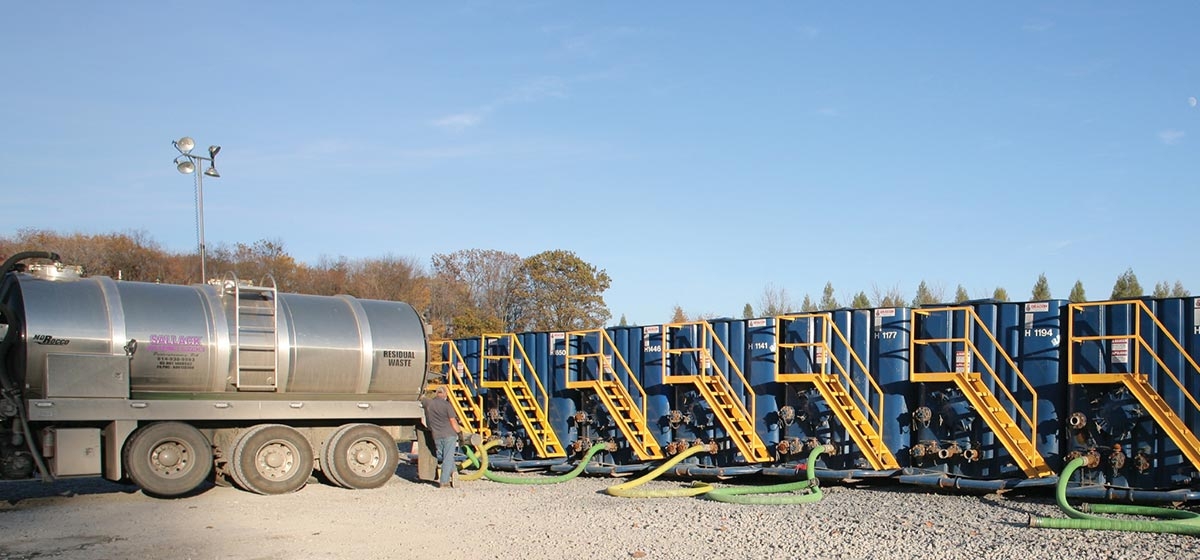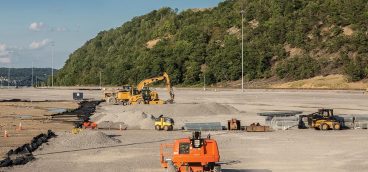
The rig, a 70-foot steel spire, soared above the manmade moonscape atop the plateau that Chesapeake Energy’s contractors had hewn out of the hillside on my family farm in Wyoming County.
And as my 8-year-old daughter and I trekked along the ridge above it to get a better look, I was struck with an odd and queasy feeling. It’s not that I hadn’t seen this sort of thing before. Over the past two years, while working on my book about the perils and promises of the Marcellus shale, I’ve been to plenty of drill sites, but always as a visitor, a detached observer, a journalist. This time, it was different. This time, it was my family’s land, my children’s legacy that I was observing. This time I had skin in the game.
From up there on the ridge, my daughter and I could see it all: the rig, the massive pump that would force a few million gallons of chemically laced water a mile deep into the earth to shatter the rock below and release the gas, the massive tanks that would hold the water that Chesapeake would soon have carted to the site to do the job, and the ominous-looking tanks that would hold that portion of the tainted water that would flow back to the surface. They were surrounded by an earthen berm, lined with a black, rubberized material as a precaution in case something went wrong.
To my right, and beyond the pad, I could look down and see the small stream where I used to torment frogs as a kid. A hot, dry summer had reduced it to a trickle as it snaked its way down from our hill to meet up with Meshoppen Creek, tumbling down from there to the Susquehanna River. In all the 40 years since I first frolicked along that tiny stream, I had never seen it look so vulnerable. To my left, I could look out over a series of rolling hills toward the last ridge that dipped down toward the village of Dimock, a crossroads town in the middle of nowhere that has, fairly or unfairly, become nationally known as the poster child for almost everything that can go wrong with natural gas drilling.
I had been told by Chesapeake officials that the hydraulic fracturing operation on my family’s farm would be state-of-the-art, that the kind of problems with groundwater contamination that had occurred in Dimock and elsewhere were unlikely, that the technology used to prevent spills and to handle the wastewater from drilling had advanced mightily just in the past two years.
But for some reason, call it my native mistrust or chalk it up to the fact that this time it was my land, I didn’t feel all that comforted.
Over the past two years, I’ve been around enough drillers, engineers and scientists to know that there’s no such thing as zero risk. Nothing is impossible.
Take the danger of groundwater contamination, for example. Geologists and engineers who have studied the Marcellus, for the most part, contend that there is little likelihood that the potent mix of chemicals added to the frack water will somehow infiltrate underground water supplies. Nor, they say, is there much of a risk that equally troubling elements, such as strontium and barium and radioactive materials contained in the naturally occurring brine in the Marcellus shale, will work their way up from the depths on their own and into my drinking water supply or the state’s. There is, they point out, a rock barrier, multiple layers thick and more than a mile deep, that would almost certainly prevent contamination from occurring that way. As John Veil of the Argonne National Laboratory in Illinois puts it, “It seems to me that the biggest concern that’s driving the fear is the unknown nature of the chemicals that are placed in the ground. People think that if you’re putting it into the ground… it’s immediately going to pump into your well water.”
That, he says, is not the case. But that’s not to say that drilling does not pose a significant risk to water supplies. In fact, there have already been several high-profile cases of groundwater contamination. In Dimock, for example, the state Department of Environmental Protection has cited Cabot Oil and Gas, both for surface spills and for shoddy construction practices that allowed natural gas from a deposit above the Marcellus to drift into the drinking-water wells of 14 residents. Currently, Cabot is providing drinking water for those residents, and the state says it may force the company to pick up the $10 million tab for building a pipeline to bring fresh water to those residents from the municipal water supply in Montrose. Just recently, some of those same residents, who have filed suit against Cabot, released the findings of water tests that showed traces of toluene, ethylbenzene and xylene—chemicals that are sometimes used in fracking and are common in gasoline and diesel—in some of the water wells in the area. Cabot maintains that its contractors used none of those chemicals in their fracking and that none of the five diesel spills it was involved in while drilling nearby wells was a factor.
A few miles to the north, in Lenox, 13 residents have filed a suit against Southwestern Energy Production Co., claiming that that their water wells were contaminated by high levels of strontium, barium and manganese, elements commonly found in the naturally occurring deep shale brine. Although the DEP has said that it cannot positively link the contamination to drilling activities, the agency’s records show that it has cited Southwestern four times in the past for failing to maintain a waste pit, failing to control erosion at at least one of its drill sites, and failing to post appropriate permits.
Such incidents, while not exactly common, have fueled the mounting public anxiety about the dangers of the development of the Marcellus and have exacerbated a growing division between the two increasingly dogmatic sides of the debate. On the one side, there are the anti-drilling forces, galvanized in their opposition by the kind of images of desolation and destruction that filmmaker Josh Fox compiled and in some cases conflated in his anti-drilling film “Gasland.”
Critics of the film contend that it is less a documentary than a manifesto, a brand of theater of the same genus and species as the controversial and somewhat distorted work of James O’Keefe, the young, ultra-conservative activist who dressed up like a pimp in order to discredit ACORN. In its review of “Gasland,” the New York Times took Fox to task for his approach, arguing that he “shows a general preference for vivid images… over the more mundane crossing the t’s and dotting the i’s of investigative journalism,” and adding that, in some cases, he appears to have ignored crucial details that would lend perspective to his piece. “In one particularly unfortunate decision, he includes audiotapes of an anonymous caller—even he doesn’t appear to know who she is—accusing Halliburton of dumping chemicals in a Pennsylvania creek. He presents a despairing picture of conditions in the Susquehanna Valley without noting that there have been state investigations of unsafe practices there. As the film progresses, the lines between fracking and oil and gas production in general become blurred.”
On the other extreme, there are the gung-ho pro-drilling advocates who contend that cases of contamination are rare and are being exploited in an attempt to choke the gas industry in Pennsylvania to death in its cradle, but they offer little in the way of proof to bolster such arguments.
Such extreme positions certainly get the headlines. And as it is with almost every other critical issue facing the country at the moment, it is the extreme positions, articulated in a way that is designed to inflame but not necessarily inform, that are getting the most attention. But according to scientists, engineers, policy makers and experts in the field, the increasingly acrimonious partisan debate has all but drowned out any discussion of the real challenges posed by the development of the Marcellus in terms of water use and disposal.
The truth is there are actually two species of challenges. The first is a technical problem, a mechanical one. That’s the category that the troubles in Dimock—and to the degree that it’s confirmed, the incidents in Lenox—fall into, according to the DEP and others who have studied them. In Dimock, the DEP concluded that Cabot’s drilling operation disturbed an existing reservoir of methane, and that poorly cemented well casings allowed that gas to drift into an underground water supply. In response to that, the DEP began tightening its regulations regarding cementing and, though hobbled by budgetary restraints, began cracking down statewide on drillers to make sure that they were taking appropriate steps to reduce the likelihood that such accidents will occur. The state also has begun to monitor more closely the work above ground with an eye toward reducing the potential for surface spills of frack fluid, brine water, or even diesel fuel that could affect water supplies.
In those cases, the mechanical problems can in the long run be corrected with a mechanical solution, the DEP contends.
But the larger problem is a systemic one, and in essence it comes down to this: to develop the gas in the Marcellus fully, hundreds of millions of gallons of fresh water will have to be treated with a variety of chemicals. On average, it takes 2.7 million gallons of water to frack a Marcellus well, and it will be pumped deep into the earth. While most of it will stay down there, as much as a third of it can be expected to return to the surface. And that figure may be high. According to a federal Department of Energy report released in the summer and based on anecdotal evidence collected over the past several years, it can be estimated that, on average, about 13.5 percent of the water injected into a Marcellus well will flow back. Over time, it will be followed by the even more treacherous and naturally occurring witch’s brew euphemistically called “produced water” that will continue to leach out of the well heads for years, for decades, perhaps even for a generation or more. Do we now have the infrastructure in place to handle the water we’re already generating, to treat it to levels where it will pose a minimal risk if it does enter the water cycle? And do we have a plan in place in Pennsylvania to ensure that we will have the capacity to treat the flowback and produced water as the Marcellus grows?
That, says Dan Volz, an assistant professor at the University of Pittsburgh and director of the Center for Healthy Environments and Communities, “ultimately will be a billion-dollar question for the industry.”
It’s a question that has been growing both in urgency and complexity as the development of the Marcellus has grown, says Jeanne VanBriessen, an engineering professor at Carnegie Mellon University and director of the school’s Center for Water Quality in Urban Environmental Systems. Up until about two years ago, the emerging gas industry in Pennsylvania was content to use the same kind of patchwork system that it had employed in less-populated and less-regulated states in the South and West. The flowback water and whatever brine was produced during the production of those early wells was collected, usually in large, open pits, where it would evaporate. Then, periodically, the water in the pits would be siphoned up and shipped off. Sometimes it went to one of a handful of sites in Ohio where, unlike most of the state of Pennsylvania, the geology permitted the construction of deep wells drilled into porous formations where the water could be pumped, a process called deep well injection. Sometimes it was shipped to commercially owned facilities specializing in the treatment of industrial wastewater or to publicly owned wastewater treatment facilities. There, the water could be treated, diluted and released back into Pennsylvania’s rivers and streams.
As many as 40 facilities across the state began accepting wastewater from the Marcellus. That raised the alarm for environmentalists who worried that the publicly owned sewage plants were ill-equipped to deal with the particular hazards of Marcellus wastewater. As Volz put it, “oil and gas wastewater should not be put into sewage treatment plants, period. The problem here is that oil and gas wastewater—and those people in Western Pennsylvania who grew up with steel mills know this in their core—calling this water is a misnomer. It’s as much water as the pickling brine in a steel mill is water. It’s not water. It’s a highly toxic fluid, and the sewage treatment plants essentially do very little to remove high levels of salts and they do nothing to remove the metals… They’ll do something to remove some of the organic compounds… but won’t remove all of it, and so we know we’re putting this stuff into our surface water, that’s just a public health no-no. A big no-no.”
Beginning in 2008, the problems with the existing system became apparent. A prolonged dry spell had reduced the water levels in the already stressed Monongahela River, and as the waters dried up, regulators began to notice higher than usual levels of salts and other elements, known as total dissolved solids (TDS), in the river and its tributaries.
To be fair, says Tom Rathbun, a spokesman for the DEP, the drilling industry was responsible for only a small percentage of the increase, perhaps as little as 10 percent. “It’s not like the drilling industry [made] it any worse,” Rathbun said. Mine operators, factories, the steel industry and even food processing had all loaded the Monongahela watershed to the limit when the gas industry began expanding into Pennsylvania. But something had to be done, and the DEP telegraphed to the industry that it would soon establish stricter controls over the levels of TDS and salts that could be deposited in the state’s waterways. Those new standards finally went into effect over the summer.
Seeing the handwriting on the wall, drillers began casting about for an alternative. Deep well injection, which they had commonly used in other shale plays in Texas and Wyoming, was not an answer. Not only was the geology in Pennsylvania not conducive to it, but there weren’t enough wells in Ohio to meet the demand, and that state had indicated that it planned to begin charging a premium to out-of-state companies that wanted to use them. By 2009, several of the larger drilling companies operating in Pennsylvania had hit on at least a partial answer. Recycling.
Instead of simply diluting and dumping the wastewater from its wells, several drilling companies, including Range, Chesapeake, and Atlas, began collecting their flowback, often abandoning the leak-prone old pits for closed containment systems, mixing it with fresh water, and then reusing it in their next well. And their next. And the one after that. Currently, Range contends that it uses 100 percent recycled water in its fracking operations, and other major companies make similar claims. It was, and remains, a promising solution. Not only does recycling reduce the amount of water discharged into the state’s water supplies, it also reduces the amount of water the drillers need to draw from those waterways in the first place. What’s more, Carnegie Mellon University, among others, is studying the use of other, already contaminated sources of water, such as acid mine drainage, to determine whether those waters can be added to the fracking mix, and some of the drillers have begun their own experiments with such “stressed” water.
But recycling is not without its drawbacks. Despite pressure from both the DEP and environmental groups to monitor and reduce the amounts of contaminants treated and pumped into the state’s waterways, many smaller and midsize companies have not embraced recycling. And the state, so far, has not shown any real inclination to make it mandatory. And even among those companies that are recycling, there are significant challenges. One of the key problems is that the Marcellus wastewater, with its high concentrations of salts and chemicals, poses a risk to drilling equipment and to the pipes that carry the natural gas up from underground. To reuse the water effectively, it must be treated, and that can be both complicated and costly. The DEP estimates that effectively treating Marcellus wastewater could cost upwards of 25 cents per gallon, a staggering amount when you consider that, as the development of the Marcellus expands, there could be as many as 20,000 wells drilled in the state, each producing tens and perhaps hundreds of thousands of gallons of wastewater.
So far, however, several of the larger drillers have been willing to ante up, and that has attracted the interest of entrepreneurs and engineers who are willing to spend big bucks to build and equip specialized treatment plants that can handle Marcellus wastewater; delete, distill, remove or reduce the most troubling elements in it, and in many cases, return it to the driller to use again. As of this past summer, there were 27 companies in Pennsylvania that were permitted by the DEP to treat Marcellus wastewater to a level where it could, if need be, be discharged into the state’s waterways; four more were licensed to treat it to a level where it could be funneled through existing sewer lines to publicly owned facilities; and there were 25 other companies seeking permits to do one or the other of those things. In the summer for example, after a two-year permitting and construction process, Reserved Environmental Services (RES) opened its $30 million treatment plant at the old Sony plant near New Stanton in Westmoreland County, a facility that, according to company CEO Andrew Kicinski, currently treats between 400,000 and 500,000 gallons of water each day, returning it to the driller for reuse. The plant, which employs 14 workers over two shifts, dumps none of its water into public waterways, Kicinski said. “From the very start, we were going to be a zero-discharge facility. Total recycle. Treat the water and remove certain constituents, pollutants, and we return the water to the driller… one gallon in and one gallon out.” The process, which takes about three and a half hours to complete, is complicated, but essentially, the plants cook out barium, strontium, suspended solids and oil, and those are turned into a kind of sludge, which after careful inspection, Kicinski said, can be shipped to a sanitary landfill for disposal. The water that the drillers cart back to their next well is not pristine, of course. It’s loaded with salt. “You can tell your readers that it’s four times saltier than the ocean,” Kicinski said. But drillers such as Range Resources, one of Kicinski’s larger customers, don’t object. They cut the salty recycled water with fresh water and, in so doing, reduce their water consumption by 25 percent and eliminate the need to discharge wastewater, says Matt Pizzarella, a spokesman for Range. In fact, RES is planning to build a second treatment plant at the same facility, expecting completion within 18 months. That facility will use evaporation and crystallization technology that will be capable of sufficiently scouring the wastewater of solids and chemicals to the point where it could be discharged under the state’s water standards if need be. Within three years RES expects to complete a third plant to serve the active Marcellus drilling fields in the northeastern part of the state.
Several other companies have either received permits or are proposing plants across the state that would effectively do the same sort of thing as the RES plant. But the price tag for such facilities is steep, running between $30 million and $60 million per plant. Assembling that kind of money in an economy as sluggish as this one is no easy task, and there is no guarantee that the number of plants will keep pace with the growing need for them as the development of the Marcellus progresses. But the fact that some of the larger drillers, perhaps because of pressure from the state and from environmental groups, have thus far been willing to pay the price to treat their water and reuse it, and that they’ve been willing to do it at a time when gas prices are far below their historic highs, should be an encouraging sign for investors.
As Veil of the Argonne lab put it, “An awful lot of the business revolves around the selling price of natural gas. We seem to be at a relatively low point in the cycle now, and it’s been relatively low for a couple of years. If natural gas jumped another dollar per [thousand cubic feet] the companies would have… the cushion to spend more on water treatment… If they’re able to do it now, and if they’re making more money… selling gas, they’ll be able to do it even more easily in the future.”
As promising as those technologies are, however, they still are not universally accepted. There are still drillers who rely on overburdened publicly owned treatment facilities to handle their wastewater, and others who are carting their waste off to Ohio or elsewhere for disposal. “We have these treatment options and we have a lot of decisions to make about which of those options are the most economical, which of those options are best for the environment,” said Carnegie Mellon’s VanBriessen. “I think we do have to sit down and make those decisions. They haven’t been made, and they’re being made on an ad hoc basis.”





